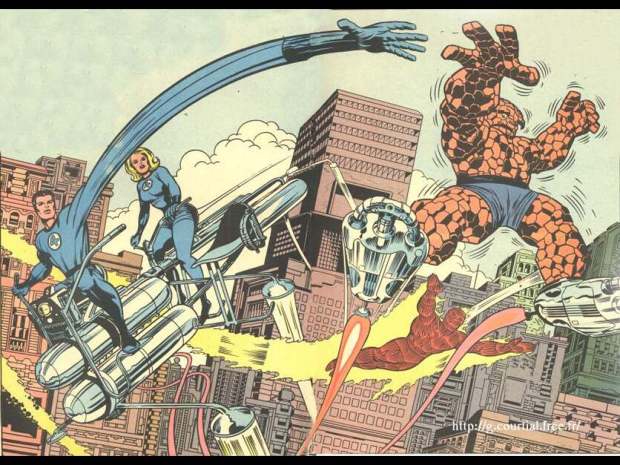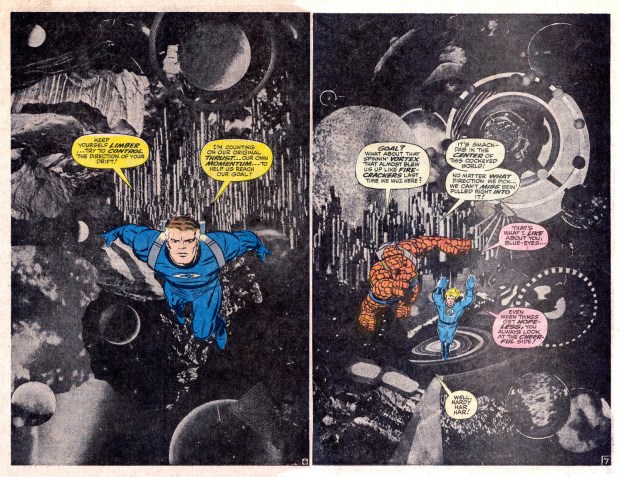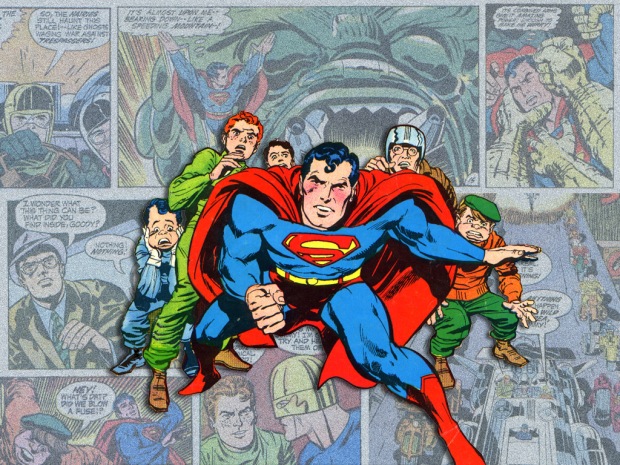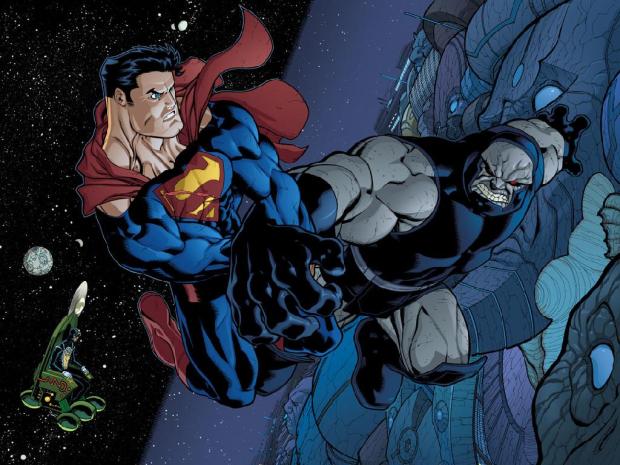In November 1961 The Fantastic Four #1 hit the newsstands across America. The story of four uniquely powered individuals related to each other as relatives, in friendship and purpose, revolutionised the industry. Although clearly reminiscent of hundreds of Sci-fi books before this had a comparative naturalism to it that hadn’t been seen before blended with a cosmic purview informed by boundless imagination. It was powered by Marvel Editor-in-chief Stan Lee and seasoned comics artist Jack Kirby.
For almost a decade, Kirby provided Marvel’s house style, co-creating with Stan Lee many of the Marvel characters and designing their visual motifs. At Lee’s request he often provided ‘new-to-marvel artists ‘breakdown’ layouts, over which they would pencil in order to become acquainted with the Marvel look. As artist Gil Kane described:
‘Jack was the single most influential figure in the turnaround in Marvel’s fortunes from the time he rejoined the company … It wasn’t merely that Jack conceived most of the characters that are being done, but … Jack’s point of view and philosophy of drawing became the governing philosophy of the entire publishing company and, beyond the publishing company, of the entire field … [Marvel took] Jack and use[d] him as a primer. They would get artists … and they taught them the ABCs, which amounted to learning Jack Kirby. … Jack was like the Holy Scripture and they simply had to follow him without deviation. That’s what was told to me … It was how they taught everyone to reconcile all those opposing attitudes to one single master point of view.’
Highlights from the House of Ideas other than the Fantastic Four include: Thor, the Hulk, Iron Man, the original X-Men, the Silver Surfer, Doctor Doom, Galactus, Uatu the Watcher, Magneto, Ego the Living Planet, the Inhumans and their hidden city Attilan and the Black Panther – comic’s first black superhero – and his African nation Wakanda. Last year and 2010 Thor, Iron Man and the X-Men grossed worldwide ($1,425,062,845) One Billion, four hundred and twenty five million, sixty two thousand, eight hundred and forty five dollars (A combination of $623,933,331 for Iron Man 2, $448,512,824 for Thor and $352,616,690 for X-Men: First Class). This was begun by two men, one of which was Jack Kirby. They cemented the concepts so clearly that while developed, the core values remain. All of them have the best writers, directors and actors vying to be a small part in the development of these ideas formed 51 years ago. Decades of the most talented artists have looked to Kirby for inspiration. His ideas as only presented more clearly, barely changed from the original concept design – perhaps drawn, in one case, on a table in Brooklyn many years before – with thoughts of war he hadn’t yet been called on to fight in his mind.
In March 1964, Simon and Kirby’s Captain America was also incorporated into Marvel, Kirby approving Lee’s idea of partially remaking the characters as a man out of his time and regretting the death of his partner. The suit returned almost exactly as it had been 23 years before. Last year, Captain America made $368,608,363 at the box office as Kirby’s suit stepped, again almost unchanged close to 70 years after the day it was designed on the back of Chris Evans.
In 1968 and 1969, Joe Simon was involved in litigation with Marvel Comics over the ownership of Captain America, initiated by Marvel after Simon registered the copyright renewal for Captain America in his own name. According to Simon, Kirby agreed to support the company in the litigation and, as part of a deal Kirby made with publisher Martin Goodman, signed over to Marvel any rights he might have had to the character.
Kirby continued to push the industries boundaries, devising photo collage covers and interiors reminiscent of ’80s artists in England playing with sellotape and photocopiers. Developing new drawing techniques such as the method of depicting energy fields known as ‘Kirbydots’ and other experiments. Able to handle high detail, explosive composition, emotion, perspective, conceptualisation and design – it was Kirby’s sense of scale that blows many artists away. Alien engines dwarf figures in certain panels, coils, springs and rivets collected together in such ways that they seem to be an optical illusion. Perspective twists in some of his environments such as Mr Fantastic’s lab in a way that somehow bends the eye. Many generations of artists have dismissed Kirby as dated or unsophisticated until presented with his depictions of machinery and the Silver Surfer.
A character of incredible simplicity, divinity and … just … cool. The concept of a humanoid riding the waves of space at incredible speeds highlights the natural beauty and associations with divine advancement incorporating the universe around it and the increased simplicity it brings. But none of that is said. But all of it is inherent. A perfectly formed, universally accessible character made even more interesting by Stan Lee by being a good man acting as herald to a being of unimaginable power. Again, the genius of the character is that it is a perfect template that can be adapted into anyone’s style. Much like any Kirby character you can mention. The simplicity and intuitive details he applies are often so universal that they are only more interesting with each new reinterpretation. While Iron Man had to inevitably change as technology developed, Thor still carries the same Hammer and wears the same white riveted top, Captain America still has his Red, White and Blue, the star on his chest and the skull cap design applied to him in the newest incarnation, the Ultimates, by Bryan Hitch is a throwback to Kirby’s original design, Hulk remains Green (as he was in his second appearance) and even had a Grey countenance as Peter David’s Joe Fixit in the ’90s – a nod to the original design. Black Panther, Magneto, The Inhumans and Attilan have also only ever been refined – never redesigned. This is the testament to the lasting influence of Kirby. Even the X-Men have retained the yellow and blue of their original uniforms for more than 45 years. Somehow Kirby just knew. Wiser than the rest of us what he put down on paper worked and generations of artists have never cracked how to improve on his original designs.
Yet, Kirby grew increasingly unhappy at Marvel. The reasons given for this included resentment over Stan Lee’s increasing media prominence, a lack of full creative control, anger over breaches of perceived promises by publisher Martin Goodman and at Marvel specifically for lack of credit for his story plotting, character creations and co-creations. He began to both script and draw some secondary features for Marvel, such as “The Inhumans” in Amazing Adventures, as well as horror stories for the anthology title Chamber of Darkness, and received full credit for doing so; but he eventually left the company in 1970 for rival DC Comics, under editorial director Carmine Infantino.
Spending nearly two years trying to negotiate a three year contract with the option of staying on a further two additional years. In 1970, at the age of 53, Kirby joined DC and immediately started creating a ‘Fourth World’. A trilogy of New Titles – New Gods, Mister Miracle and The Forever People. He took on Superman’s pal Jimmy Olsen because the series was without a stable creative team and he didn’t want to be responsible for losing anyone their job. The central villain of the Fourth World, Darkseid, and some other Fourth World concepts appeared in the pages of Jimmy Olsen before being launched as their own series, giving greater exposure to potential buyers. Jack Kirby remained an incredibly shrewd operator, still demonstrating the guile and forward thinking that is expected of great creative directors. Though here he was without a company, working as he had always wanted to. As a creative.
Kirby had a lasting effect on DC too, leaving characters that have recurred or consistently remained in the DC Universe, though not as centrally as the Marvel Universe. These included OMAC (seen in the Final Crisis crossover of 2009), Kamandi, The Demon, The Losers, Dingbats of Danger Street, Kobra and together with old partner Joe Simon for one last time, a new incarnation of the Sandman.
But it had to be said that rather than Kirby having Marvel blood in his veins, Marvel ran on Kirby Engine Oil and the company would always have taken him back. In 1975, Stan Lee used a Fantastic Four discussion panel to announce that Kirby was returning to Marvel. Ever the showman, Lee wrote in his monthly article ‘Stan Lee’s Soapbox’ that “I mentioned that I had a special announcement to make. As I started telling about Jack’s return, to a totally incredulous audience, everyone’s head started to snap around as Kirby himself came waltzin’ down the aisle to join us on the rostrum! You can imagine how it felt clownin’ around with the co-creator of most of Marvel’s greatest strips once more.”
Back at Marvel, Kirby both wrote and drew Captain America and created the series The Eternals, which featured a race of inscrutable alien giants, the Celestials, whose behind-the-scenes intervention in primordial humanity would eventually become a core element of Marvel Universe continuity. Kirby’s other Marvel creations in this period include Devil Dinosaur, Machine Man, and an adaptation and expansion of the movie 2001: A Space Odyssey, as well as an abortive attempt to do the same for the classic television series, The Prisoner. He also wrote and drew Black Panther and did numerous covers across the line.
Still dissatisfied with Marvel’s treatment of him and with the companies refusal to provide health and other employment benefits, Kirby sadly left Marvel to work in animation. In that field, he did designs for Turbo Teen, Thundarr the Barbarian and other animated television series. He also worked on The Fantastic Four cartoon show, reuniting him with scriptwriter Stan Lee. He illustrated an adaptation of the Walt Disney movie The Black Hole for Walt Disney’s Treasury of Classic Tales syndicated comic strip in 1979-80.
In the early 1980s, Pacific Comics, a new, non-newsstand comic book publisher, made a then-groundbreaking deal with Kirby to publish a creator-owned series Captain Victory and the Galactic Rangers, and a six-issue mini-series called Silver Star which was collected in hardcover format in 2007. This, together with similar actions by other independent comics publishers as Eclipse Comics (where Kirby co-created Destroyer Duck in a benefit comic-book series published to help Steve Gerber fight a legal case versus Marvel), helped establish a precedent to end the monopoly of the work for hire system, wherein comics creators, even freelancers, had owned no rights to characters they created.
Though estranged from Marvel, Kirby continued to do periodic work for DC Comics during the 1980s, including a brief revival of his “Fourth World” saga in the 1984 and 1985 Super Powers mini-series and the 1985 graphic novel The Hunger Dogs. And in 1987, under much industry pressure, Marvel finally returned much of Kirby’s original art to him.
Kirby also retained ownership of characters used by Topps Comics beginning in 1993, for a set of series in what the company dubbed “The Kirbyverse”. These titles were derived mainly from designs and concepts that Kirby had kept in his files, some intended initially for the by-then-defunct Pacific Comics, and then licensed to Topps for what would become the “Jack Kirby’s Secret City Saga” mythos. Marvel posthumously published a “lost” Kirby/Lee Fantastic Four story, Fantastic Four: The Lost Adventure (April 2008), with unused pages Kirby had originally drawn for Fantastic Four 108 (March 1971).
On February 6, 1994, Kirby died at age 76 of heart failure in his Thousand Oaks, California home. He was buried at the Pierce Brothers Valley Oaks Memorial Park, Westlake Village, California.
Kirby’s legacy is enormous. Grant Morrison’s Final Crisis crossover hinged on Kirby’s Fourth World – specifically Darkseid himself – inflicting themselves on Earth, Captain America still leads the Avengers / Ultimates in colours picked out for him by a man he could have fought in the war with. The Hulk continues to smash, the Surfer continues to glide through the Marvel Universe. Artists around the world look to Kirby’s example of steadfast, unfussy iconography, simple, effective design and dizzying compositions. A generation of Marvel artists were trained by him. But more important than that, Jacob Kurtzberg of Suffolk Street, New York City built dreams others could build upon while simply building his own. He has influenced and inspired thousands of creatives (including this one) and built a House of Ideas that millions of people continue to enjoy. Kirby is a true legend to those who know, possibly the greatest comic book artist who ever lived. Responsible for the Incredible Hulk, Iron Man, Captain America, Thor, Mr Fantastic, Invisible Woman, the Thing and The Human Torch. If they existed, all of them would have visited the grave of Jack Kirby. The Hulk would have stood in the rain over Kirby’s resting place, a giant over a small guy’s crypt and simply said ‘Goodbye Dad’. With that, the broad shouldered goliath would turn and launch himself up into the sky, disappearing into the distance. If Kirby, lying where he was could see it he’d have thought ‘Good angle, but perhaps it could be just a little tighter…’








